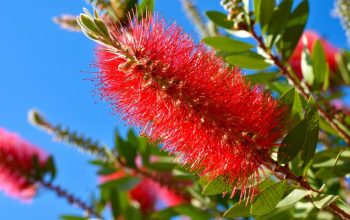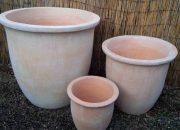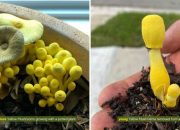Succulent Care and Maintenance in Pots

Succulent plant with pot – Maintaining healthy and happy succulents in pots is a delightful journey, a bit like tending to a miniature, spiky garden in your home! With a little understanding of their needs, you can ensure these resilient plants thrive and bring joy to your space. Remember, proper care is key to enjoying their unique beauty for years to come.
Watering Succulents in Pots
The frequency of watering succulents depends heavily on several factors: pot size, pot material, and the surrounding environment. Smaller pots dry out much faster than larger ones, requiring more frequent watering. Terracotta pots are porous, allowing for faster evaporation than plastic or glazed ceramic pots. Hot, sunny conditions also lead to quicker drying. Always check the soil moisture before watering; stick your finger about an inch into the soil.
If it’s dry, it’s time to water. Water thoroughly, allowing excess water to drain completely. Avoid letting the pot sit in standing water, which can lead to root rot. For small terracotta pots, you might water every few days in hot weather, whereas larger plastic pots might only need watering once a week or even less.
Sunlight Exposure for Potted Succulents
Succulents need ample sunlight to thrive, generally 6-8 hours a day. However, the intensity and duration of sunlight should be adjusted according to the pot type and location. Darker colored pots absorb more heat, potentially scorching succulents in intense sunlight. In such cases, consider providing some afternoon shade. Succulents in transparent glass pots are more susceptible to sunburn, requiring protection from direct midday sun.
If your succulents are placed indoors, a south-facing window is ideal, but even then, monitor them for signs of sunburn or stretching (etiolation). Rotate your pots regularly to ensure even growth.
Common Pests and Diseases of Potted Succulents
Common pests include mealybugs, aphids, and spider mites. Mealybugs appear as small, white, cottony masses, while aphids are small, soft-bodied insects that cluster on stems and leaves. Spider mites are tiny arachnids that create fine webbing. Regularly inspect your plants for these pests. Preventative measures include ensuring good air circulation to prevent humidity buildup and maintaining a clean growing environment.
Infestations can be treated with insecticidal soap or neem oil, following the product instructions carefully. Diseases like root rot are often caused by overwatering. Ensure proper drainage and avoid letting the soil stay soggy.
Repotting Succulents
Repotting is necessary when your succulent outgrows its current pot or when the soil becomes compacted. Choose a pot slightly larger than the previous one, with drainage holes. Prepare a well-draining succulent potting mix, which is typically a blend of cactus and succulent soil, perlite, and coarse sand. Gently remove the succulent from its old pot, carefully loosening any roots that are tightly bound.
Inspect the roots for any rot or damage. Place a layer of fresh potting mix at the bottom of the new pot, then carefully position the succulent, filling in the remaining space with more soil. Water lightly after repotting, allowing the soil to settle.
Succulent plants, known for their drought tolerance, thrive in well-draining pots. However, maintaining the ideal moisture level can be challenging; consider using a self-watering system for optimal hydration. For consistent watering and healthy growth, explore the benefits of a self watering plant pot , which can significantly reduce the risk of overwatering or underwatering your succulents, thus promoting their longevity and vibrancy.
Creative Potting Ideas and Presentation

Presenting your succulents isn’t just about keeping them alive; it’s about showcasing their unique beauty! A little creativity can transform a simple succulent into a stunning centerpiece, adding a touch of vibrant life to any space. Let’s explore some fun and exciting ways to pot and present your prickly pals.
Repurposing everyday items adds a unique charm to succulent displays. Think outside the box – or rather, outside the standard terracotta pot! The possibilities are as endless as the varieties of succulents themselves.
Succulent Arrangement in a Repurposed Container
Imagine a chipped, pastel-pink teacup, its delicate floral pattern slightly faded with time. This charming vessel, rescued from a dusty attic, now cradles a trio of succulents. A plump
- Echeveria* ‘Perle von Nürnberg’, its rosette a perfect blush of pink and green, nestles in the center. Flanking it are two smaller
- Sedum* varieties – one with vibrant lime-green leaves, the other boasting a deep burgundy hue. The contrast in colors and textures, against the soft pink of the teacup, creates a whimsical, romantic display. The slightly imperfect nature of the teacup adds to its rustic charm, complementing the natural beauty of the succulents perfectly. The whole arrangement exudes a gentle, vintage aesthetic.
Innovative Ideas for Decorating Succulent Pots, Succulent plant with pot
Decorating your succulent pots can significantly enhance their visual appeal. Simple yet effective techniques can transform ordinary pots into eye-catching features.
Painting techniques offer a wide range of creative expression. From a simple coat of vibrant color to intricate hand-painted designs, the possibilities are limitless. Consider using chalkboard paint for a personalized touch, allowing you to easily change the design. You can also experiment with stencils to create geometric patterns or add charming quotes. Adding decorative elements like small pebbles, seashells, or colorful glass beads around the base of the plant creates visual interest and texture.
Using unique materials such as driftwood, recycled metal, or even upcycled fabric scraps can add a distinctive character to your succulent arrangements.
Succulent Arrangements for Different Interior Design Styles
The right succulent arrangement can beautifully complement various interior design styles. Here are three examples demonstrating how different plant choices and pot styles can achieve this harmony.
- Bohemian Style:
- Pot Type: A rustic terracotta pot, perhaps slightly aged or with a distressed finish.
- Succulent Selection: A mix of trailing succulents like
-Sedum morganianum* (Burro’s Tail) and
-String of Pearls*, combined with upright varieties like
-Echeveria* in varying shades of green and purple. - Overall Aesthetic: Free-flowing, slightly chaotic, with a focus on natural textures and a vibrant color palette. The arrangement might include small decorative elements like feathers or driftwood.
- Modern Style:
- Pot Type: A sleek, minimalist geometric concrete pot in a neutral color like gray or white.
- Succulent Selection: A carefully curated selection of succulents with clean lines and uniform shapes, such as
-Haworthia* or
-Aloe* varieties. Focus on monochromatic color schemes, like various shades of green. - Overall Aesthetic: Clean, uncluttered, and sophisticated. The arrangement emphasizes simplicity and symmetry.
- Rustic Style:
- Pot Type: A reclaimed wooden box or a galvanized metal bucket.
- Succulent Selection: A mix of succulents with varying textures and colors, including those with interesting leaf shapes and colors. Consider incorporating drought-tolerant grasses or small wildflowers for added interest.
- Overall Aesthetic: Natural, earthy, and slightly weathered. The arrangement aims to evoke a sense of warmth and coziness.
Creating a Layered Succulent Arrangement
Layered succulent arrangements in large pots offer a dynamic and visually captivating display. To achieve this, begin by placing larger succulents at the bottom, creating a strong foundation. Gradually add smaller succulents, filling in the gaps and creating height and depth. Consider using different textures and colors to enhance the visual appeal. Remember to ensure proper spacing to allow for growth and air circulation.
This layering technique maximizes visual impact, creating a lush and thriving miniature landscape within the pot.
FAQ Summary: Succulent Plant With Pot
What are the signs of overwatering a succulent?
Overwatered succulents often exhibit mushy leaves, root rot, and a lack of firmness. Leaves may become translucent or discolored.
How often should I fertilize my potted succulents?
Succulents require minimal fertilization. A balanced, diluted liquid fertilizer applied once or twice during the growing season is usually sufficient.
Can I propagate succulents from cuttings?
Yes! Many succulents can be easily propagated from leaf or stem cuttings. Allow the cuttings to callus before planting in well-draining soil.
What is the best time of year to repot succulents?
Spring or early summer, when the succulents are actively growing, is the ideal time for repotting.












